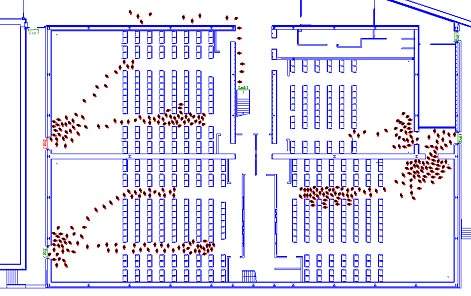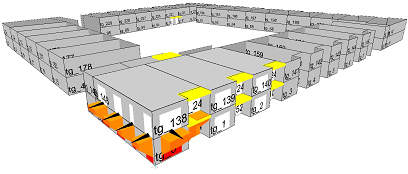STE advises clients in each and every phase of the process of constructing fireproof stations, tunnels and buildings, covering all conceivable issues related to fire safety. In close consultation with the parties involved, such as the client, local fire department and insurance company, we strive towards optimal safety at an affordable price.
Our products can be used for railway stations, metros, tunnels, offices, stores, shopping centres, distribution centres, schools, hospitals and universities.
Fire-resistant materials and constructions for stations
At STE we offer advice on the behaviour of fire-resistant materials and constructions for stations and buildings. To this end, a great deal of knowledge-exchange takes place with other disciplines within our organisation, in particular when it comes to building physics and façade technology.
In addition to this, we have developed special software for issues such as external fire spread. In this way we have even more solutions to go a step further. We want to offer safety to everyone in a building and eliminate risks.
Dynamic fire simulations for stations
STE can make dynamic fire simulations for stations, covering all kinds of fires, fire spreads, and fire-suppression and smoke-management systems, even when they are combined.
Sprinkler or water-mist installation design
STE is specialised in writing the preliminary design documents for sprinkler or water-mist installations.
Safe fire-escape routes for stations and tunnels
When the new Dutch Building Decree became effective in 2003, assessment of the aspect of safe fire-escape routes became a complex issue. STE, with its knowledge of legislation, is in a unique position to explain the consequences of the requirements for existing or new stations, tunnels and buildings.
By calculating how smoke will develop and spread in the event of fire and by comparing these results with evacuation time calculated by a computer-aided simulation, we can determine whether there is enough time to safely evacuate the building.
Fire-containment calculation/decision modelling
By Dutch building law, a fire cannot be allowed to spread without restriction. A building must therefore be sub-divided into fire compartments of a maximum size of 1,000m². The fire-containment calculation/decision model is one of the customary methods for demonstrating equivalent safety for large fire compartments.
STE has substantial experience with this model for large fire compartments and can assess this aspect in combination with the requirements for safe escape routes.
Smoke-extraction systems for stations and tunnels
Sometimes, the calculation of smoke spread reveals that a station, tunnel or building is unsafe even within just a short time. That is a particular problem if the distance to be covered to reach a safe area is sizable.
By using a smoke-extraction system to remove smoke, or an overpressure system to keep evacuation routes smoke-free, a safe situation can be created when a calculation of smoke spread reveals that a station, tunnel or building would otherwise be unsafe.
STE can help in choosing these installations and make the necessary supporting calculations. The consequences of smoke-extraction can be shown by a computer fluid dynamics (CFD) simulation.
Prevention of external fire spread for stations and tunnels
The Dutch Building Decree, fire-containment models and a number of documents related to the Dutch Environmental Management Act stipulate requirements aimed at preventing external fire spread (the spreading of fire through the ambient air) by thermal radiation.
STE can carry out calculations to substantiate stations’, tunnels’ and buildings’ compliance with the requirements. We use Pintegraal software, which calculates according to the NEN 6068 method prescribed in the Dutch Building Decree.
Post-fire investigations
If, despite all precautions, fire does break out, it is critical after the event to analyse how it happened. STE can add to the practical knowledge held by forensics experts and other investigators through its specific knowledge gleaned from fire science.
STE knows how materials, constructions and technical installations of various types can contribute to the spread of heat and smoke, or, alternatively, how they stop it.
Precisely at which point certain constructions fail can be determined on the basis of our calculations. Using the traces of the fire, we can sometimes find out where and how a fire started. What may also be important to ascertain is whether preventive measures did their job properly.














